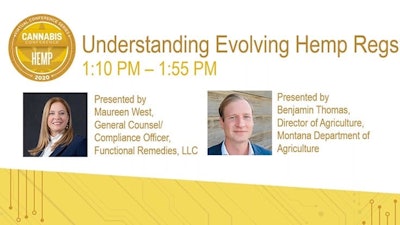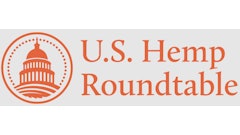
As quickly as the hemp industry is evolving, so too are its regulations on state and national levels.
On June 23, Maureen West, general counsel and compliance officer for Functional Remedies LLC and former industrial hemp program manager at the Colorado Department of Agriculture, and Benjamin Thomas, director of agriculture for the Montana Department of Agriculture, spoke candidly about the shifting regulatory landscape during the Hemp Virtual Conference, produced by Hemp Grower and Cannabis Conference and sponsored by Cannasure Insurance Services.
In their session, “Understanding Evolving Hemp Regs,” Thomas and West discussed the give-and-take hemp regulators must manage as they deal with massive sampling requirements from the U.S. Department of Agriculture (USDA) and low staffing levels.
“Our official mission at the Montana Department of Agriculture is to promote and protect agriculture, and applying that mission to hemp has been fascinating. We'll go into a meeting with a very clear objective and just end up spending three hours talking around ourselves, because where do you draw that line between promoting and protecting agriculture?” Thomas said during the session. “We definitely want the [hemp] market to develop, we want to facilitate that, but we also recognize there's a lot of risks there and we have a responsibility to mitigate that risk and also educate.”
While West says hemp license registrations have been a “moneymaker” for Colorado, Thomas highlighted the various situations states are facing—some have more growers with fewer acres, while others have a small number of growers with more acreage.
“I certainly don’t see this as money in our pockets. It’s really been a challenge to implement this from just a staff workload standpoint,” Thomas said. “When you have such different growing environments and scales of production, it’s challenging to have a uniform approach. And I think that’s why they took the approach, Congress did, in giving more control and authority to the states. Whether or not that intent was recognized fully in the [interim final rule] is another question.”
West and Thomas spoke on other disparities between Colorado and Montana in terms of regulations and compliance as well. While Colorado's current regulations are nearly up to par with the 2018 Farm Bill, for example, Montana will be facing a few major changes next growing season, including a shorter sampling window and a switch from risk-based sampling to testing all hemp varieties.
The session also covered what hurdles farmers and regulators alike will face once all states must be in full compliance with the Agriculture Improvement Act of 2018 (the 2018 Farm Bill) by next growing season.
“I think it’s going to be very interesting for the USDA officials when they actually have to implement these rules. It's one thing to have language on a piece of paper that everybody's trying to sort of interpret, and then they're trying to comply with ... but when [they] actually have to get out there and actually do it, it's going to be very interesting,” West said during the session.
To view the full session—including the regulators’ thoughts on tetrahydrocannabinol (THC) levels, cannabidiol (CBD) regulations, how farmers can develop relationships with regulators and more—along with other sessions, access the Hemp Virtual Conference video archive here.
























